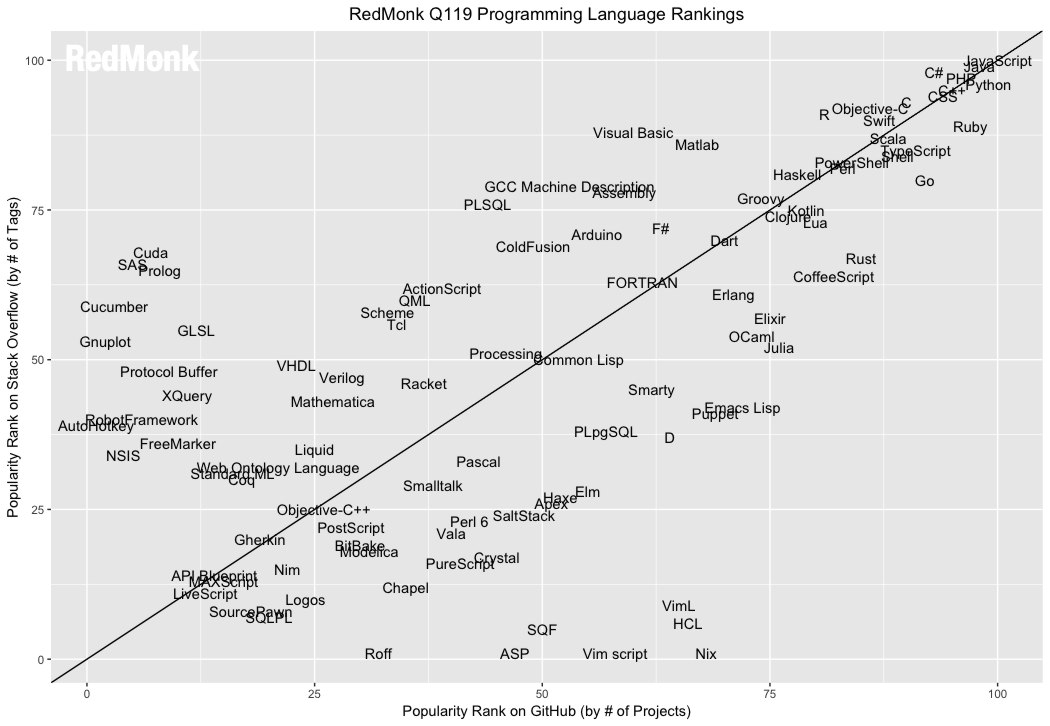| Kotlin Enters RedMonk's Top 20 |
| Written by Janet Swift | |||
| Thursday, 28 March 2019 | |||
|
RedMonk has published the latest of its twice-yearly language rankings. For the January 2019, or Q1 2019, the Top 10 remains virtually unchanged from Q3 2017 and shows only minor variation from Q3 2015. Does this reflect a lack of progress or is it welcome stability. This is the fifth time we've reported the RedMonk language rankings, which are now sponsored by IBM. This bi-annual exercise is written up by Stephen O'Grady with comments on changes on language popularity. As O'Grady reminds us, the rankings are a continuation of the work originally performed by Drew Conway and John Myles White in 2010 - see Ranking Languages for our report on the initial analysis - and combine data from GitHub and Stack Overflow to produce a ranking that attempts to reflect both code (GitHub) and discussion (Stack Overflow). As O'Grady puts it: The idea is not to offer a statistically valid representation of current usage, but rather to correlate language discussion and usage in an effort to extract insights into potential future adoption trends. Looking back at the language rankings, and our reports of them, the point that emerges strongly is that, with regard to the top programming languages the situation is fairly static - we repeatedly use "stable", "unchanged" and have even resorted to "stasis". Even on the periphery languages get added but existing ones hang around. Here is RedMonk's latest plot: (click in plot to enlarge) And to make it easier, here is the list of the latest top 10, or Tier 1 languages in RedMonk's terminology: 1 JavaScript Only change from the previous was that C and Objective-C had tied in 9th place and now C has edged ahead leaving Objective C in 10th place So what is notable this time. For this we have to look at the second tier: 11 Swift TypeScript in #12 is newsworthy. According to O'Grady: When we ran these rankings a year ago at this time, TypeScript had surged into the Top 20 landing at #17. It didn’t quite match that jump in this run, but movement within the top 20 is much more difficult to accomplish so its four spot bump is notable for that reason alone. It is also notable because by moving up four spots, it finds itself in 12th place, just outside the Top 10 and right behind Swift – the fastest growing language in the history of these rankings. The language certainly benefits from its JavaScript proximity, as well as safety features such as the optional static type-checking. But features alone are never enough by themselves to propel a language this far this quickly – it must be leveraged by a wide base of growing projects – all of which explains why TypeScript’s trajectory is significant and sustainable. The other notable change is Kotlin, which has performed a similar surge and broken into the Top 20 at #20 with O'Grady noting that: Kotlin’s growth has been second only to Swift in this history of these rankings so it will be interesting to see what lies ahead in the next run or two.
O'Grady also comments on Rust, a language whose position, #23, hasn't changed this time. Comparing it to Go, which declined by one place to #15, he writes: Rust’s glacial ascent is relatively unsurprising. Targeting similar if lower level workloads than Go, a language itself that has plateaued in terms of its placement amongst these rankings, Rust suffers from the limits of a lower popularity ceiling while not receiving quite the same attention that Go did as a product of Google generally and people like Rob Pike specifically. By comparison, Rust’s ascent has been much more workmanlike, winning its serious fans over one at a time. It’s also worth noting that even if Rust never gets much beyond where it is today, it’s still ranking higher than well known languages such as the aforementioned Clojure and Groovy, as well as CoffeeScript, Dart or Visual Basic. Not bad for a systems language. One thing I find interesting is the comparison between these rankings and the list of languages hiring managers are looking for from yesterday's report of a HackerRank survey. The top three languages are in identical places. PHP and C# come next in both, but with their order reversed, followed in both cases by C++. CSS doesn't figure in HackerRank's list of hiring managers' wants, and neither do Objective C, TypeScript and Powershell, but otherwise there is very close concordance, although Go comes higher up the pecking order. So it does seem that RedMonk is indeed providing insights that help developer's make decisions of what programming languages are worth their time and effort.
More InformationThe RedMonk Programming Language Rankings: January 2019 Related ArticlesLanguage Ranking Almost Unchanged Over Time RedMonk Rankings Reveal The Languages We Love Redmonk Language Rankings January 2017 Top Languages 2015 - Stasis But For Go And Swift Kotlin - New Language For Android To be informed about new articles on I Programmer, sign up for our weekly newsletter, subscribe to the RSS feed and follow us on Twitter, Facebook or Linkedin.
Comments
or email your comment to: comments@i-programmer.info
|
|||
| Last Updated ( Monday, 09 March 2020 ) |





